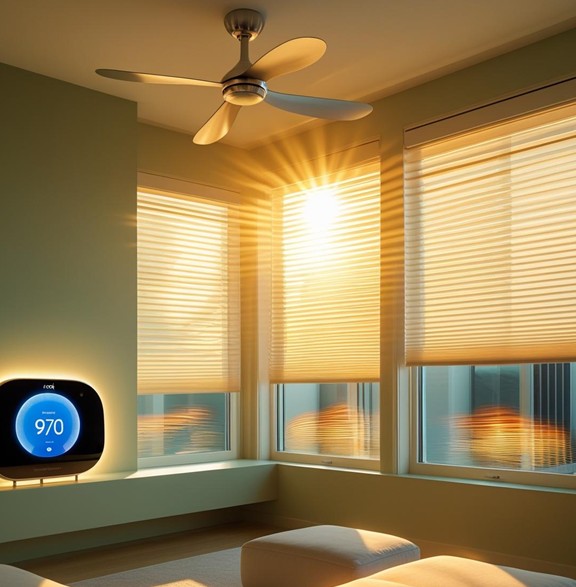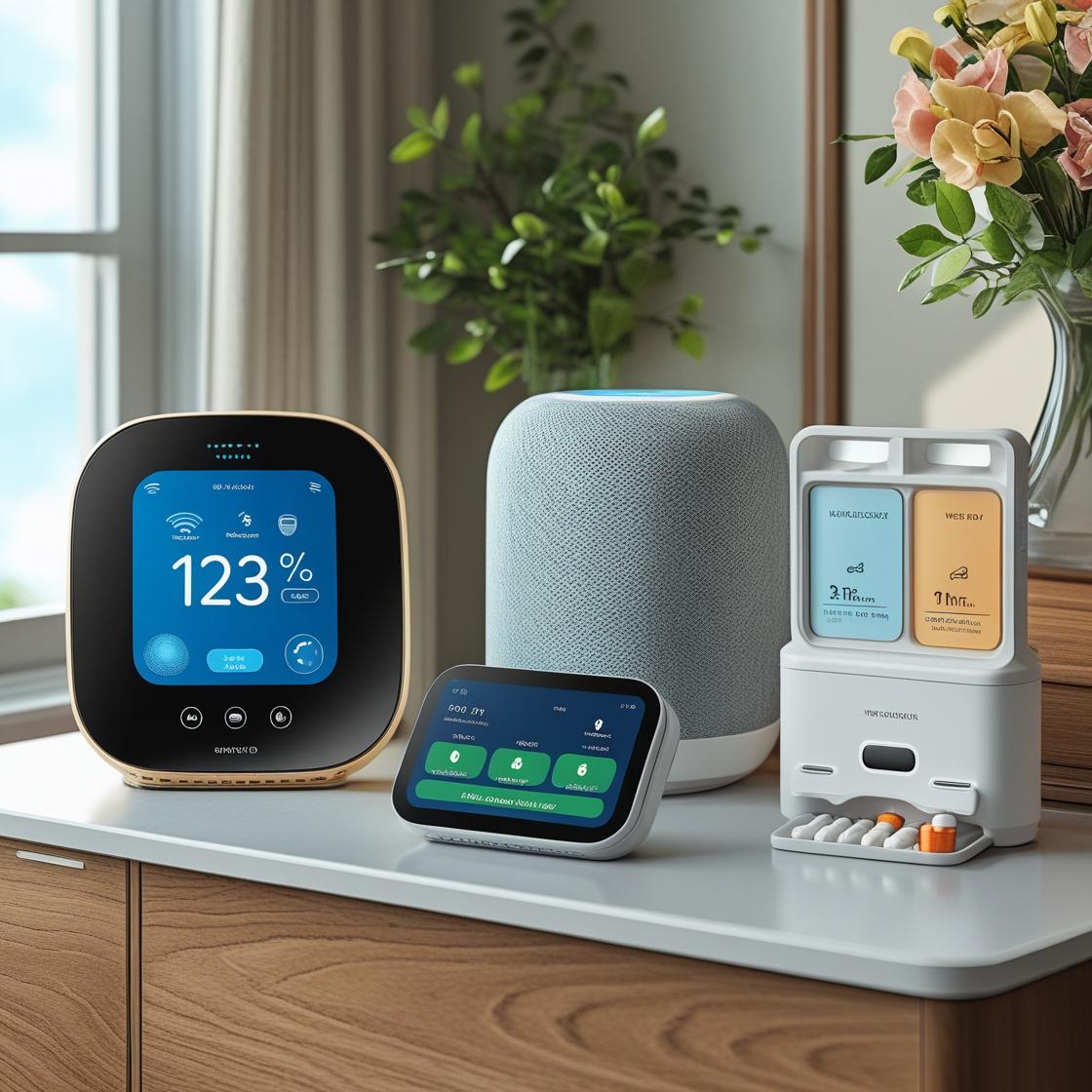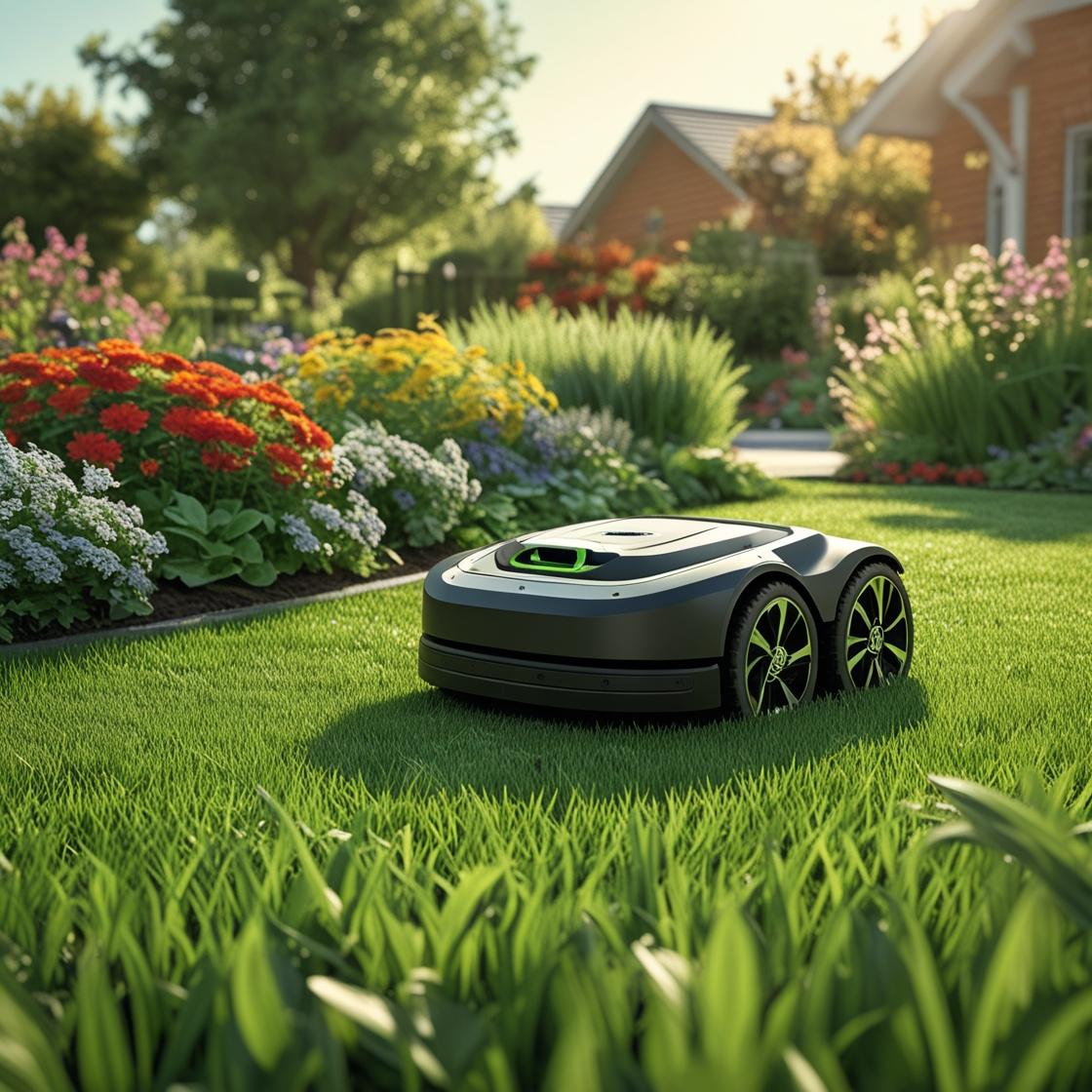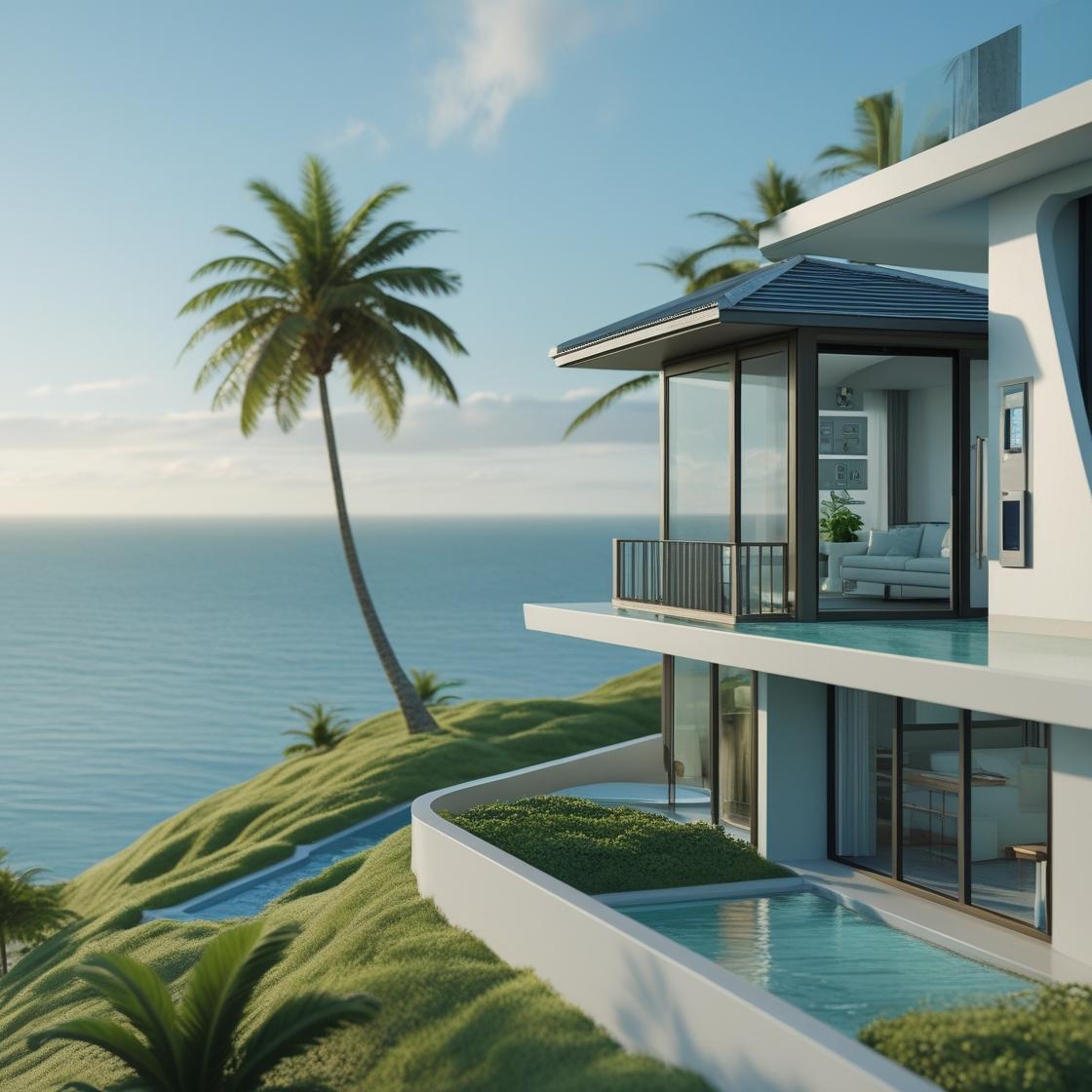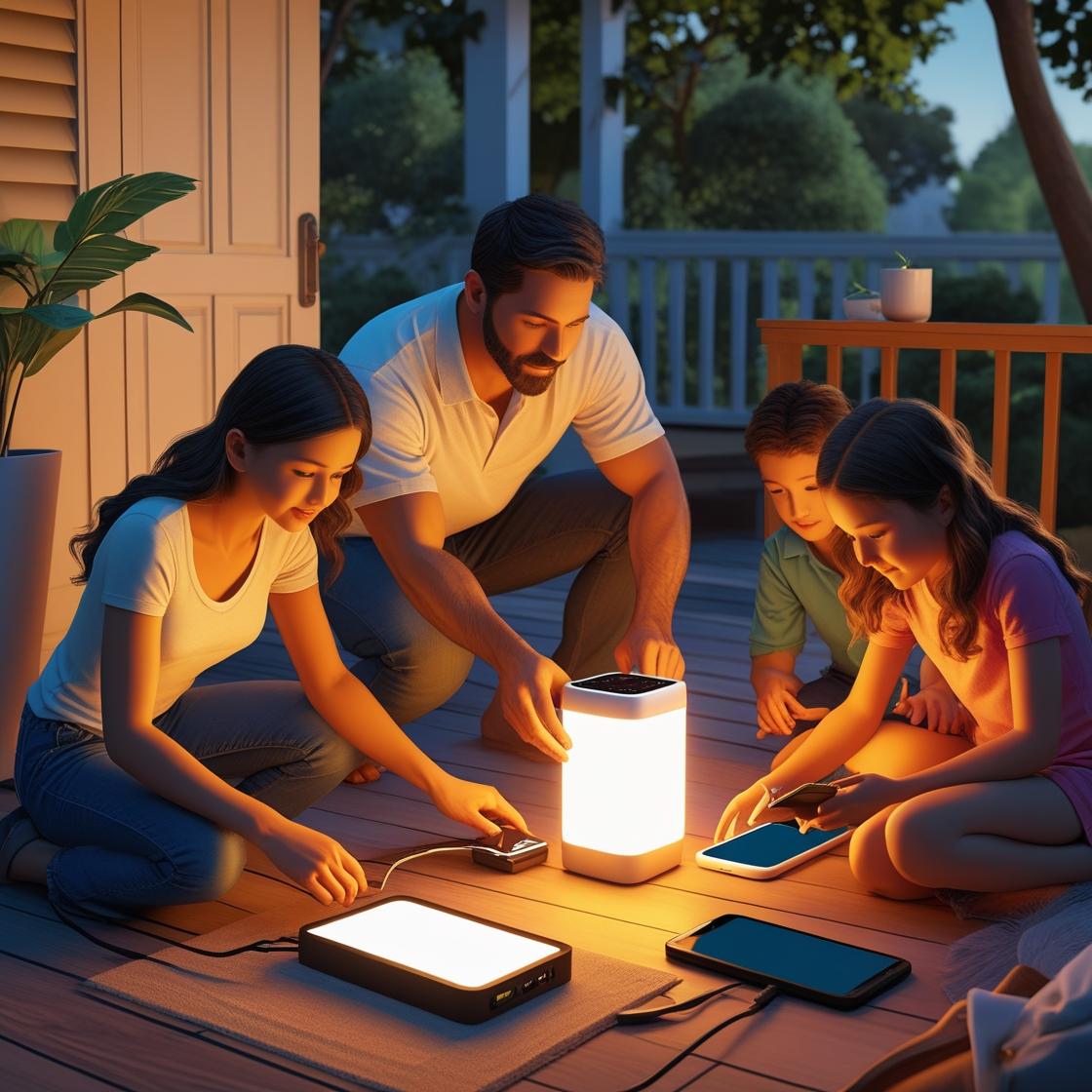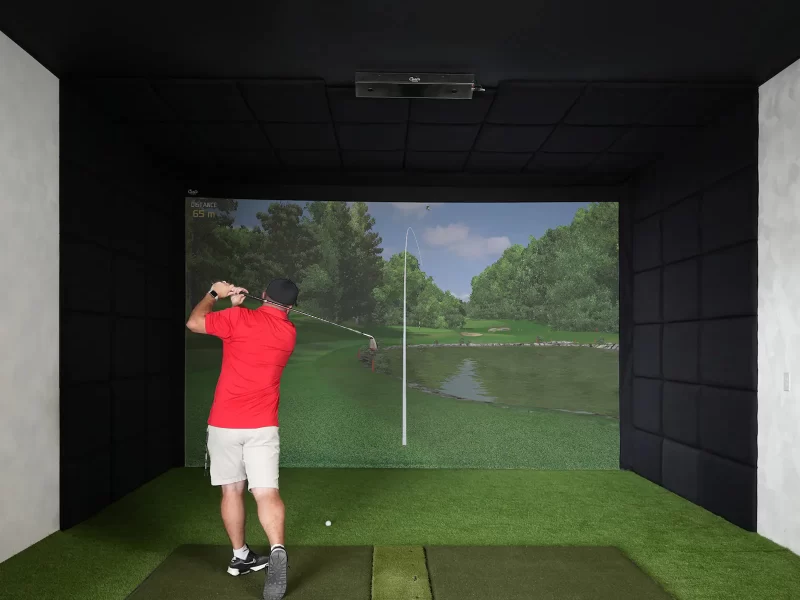A recent report shows the global golf simulator market could hit $2.3 billion by 2025 (source). No doubt that indoor golf has become more popular and more affordable. With the rise in indoor golf home simulators, the need for top-notch golf sim enclosures is higher than ever.
Finding the right golf sim enclosure is key to a great indoor golf setup. You need to think about size, materials, and how it looks. You also have to consider lighting and air flow. This guide will help you pick the best golf sim enclosure for your home. It will make your indoor golfing fun and realistic.
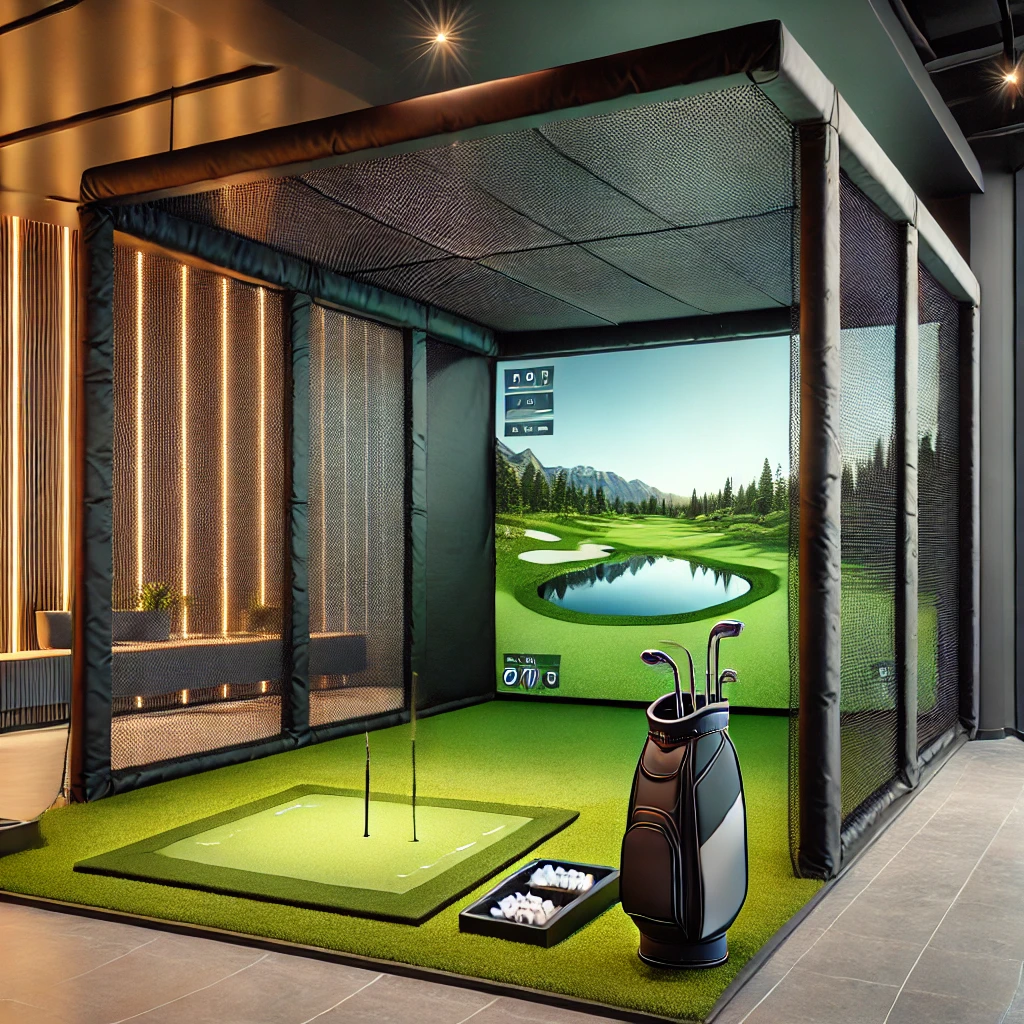
Key Takeaways
- Selecting the right golf sim enclosure is crucial for creating an immersive and enjoyable indoor golfing setup.
- Factors to consider include size, materials, framework, portability, lighting, and additional customization options.
- Proper planning and consideration of these key elements will help you choose the perfect golf sim enclosure for your home.
- By investing in the right golf sim enclosure, you can enhance your indoor golfing experience and take your game to new heights.
Understanding the Purpose and Benefits
A golf simulator enclosure is a structure designed to house the screen and projection system used in an indoor golf simulator. It typically includes a frame with fabric or netting around the sides and top, which serves several important functions:
- Containment of ball movement: The enclosure keeps the ball from going too far, protecting your space and preventing damage.
- More realistic experience: The enclosure creates a dedicated, immersive golf experience, blocking out distractions and improving the visual quality of the simulation by controlling light.
- Projection Screen Support: It holds up the impact screen where the virtual golf course is projected. The screen is durable enough to withstand the force of golf balls being hit into it.
Determining the Ideal Size
Setting up your golf simulator needs careful thought about its size. The enclosure’s dimensions depend on your available space and the size of your setup. It’s key to measure your room well to fit the enclosure perfectly and allow for your swing and ball flight.
To find the perfect size for your golf simulator enclosure, think about these important points:
- Simulator Size: Measure your golf simulator’s length, width, and height. This ensures the enclosure fits your setup well.
- Swing Clearance: Make sure there’s enough space around the simulator for your swing. Aim for at least 3 feet (0.9 meters) on all sides.
- Ball Flight: Consider the ball’s maximum flight distance. This ensures the enclosure can catch the ball without any issues.
- Accessibility: Think about the space needed for easy access to the simulator. Include any doors or walkways around the enclosure.
By considering these dimensions, you can make sure your golf simulator enclosure is the right size. This will give you a great golfing experience.
| Enclosure Dimension | Recommended Minimum | Optimal Range |
|---|---|---|
| Length | 16 feet (4.9 meters) | 18-24 feet (5.5-7.3 meters) |
| Width | 10 feet (3 meters) | 12-16 feet (3.7-4.9 meters) |
| Height | 8 feet (2.4 meters) | 9-12 feet (2.7-3.7 meters) |
The best golf simulator enclosure dimensions can vary based on your needs and space. Always measure carefully and think about all the factors for a comfortable and useful setup.
Evaluating Enclosure Materials
When picking materials for your golf simulator enclosure, think about durability and how long it will last. The right choice helps your setup last through regular use and keeps looking good. Let’s look at what to consider when choosing golf simulator enclosure material and golf simulator enclosure fabric.
Durability and Longevity Considerations
Your golf simulator enclosure needs to be tough. Look for materials that can handle frequent use without tearing. Outdoor fabrics and heavy-duty vinyl are great because they resist fading, tearing, and weather damage.
Also, the enclosure should protect against UV rays to prevent early aging and color change. This is key if it will be in direct sunlight a lot. Choosing top-notch materials now can avoid the trouble and cost of replacing them often later.
| Material | Durability | UV Protection | Maintenance |
|---|---|---|---|
| Outdoor-Rated Fabric | High | Excellent | Easy |
| Heavy-Duty Vinyl | Very High | Good | Moderate |
| Canvas | Moderate | Fair | Easy |
The table above shows a quick comparison of common golf simulator enclosure materials. Think about what you need most and pick the best for durability, UV protection, and upkeep.
“Investing in high-quality materials for your golf simulator enclosure is a wise decision that can save you time and money in the long run.”
Choosing the Right Golf Sim Enclosure Framework
The frame of your golf simulator enclosure is key. It affects stability, portability, and structure. Look at aluminum, steel, and custom frames to match your needs and budget.
Exploring Different Frame Types
Aluminum frames are popular for their light yet strong build. They resist corrosion well and are simple to set up. This makes them great for both indoor and outdoor use.
Steel frames offer a sturdy base. They ensure your enclosure can handle frequent use.
For a tailored solution, consider a custom-built frame. This lets you design the enclosure to fit your space and needs perfectly.
| Frame Material | Durability | Portability | Customization |
|---|---|---|---|
| Aluminum | High | Moderate | Limited |
| Steel | Excellent | Low | Moderate |
| Custom-built | High | Varies | High |
Choose a frame that supports your golf simulator well. Think about portability and storage too. Take your time to pick the best option for your golfing fun.
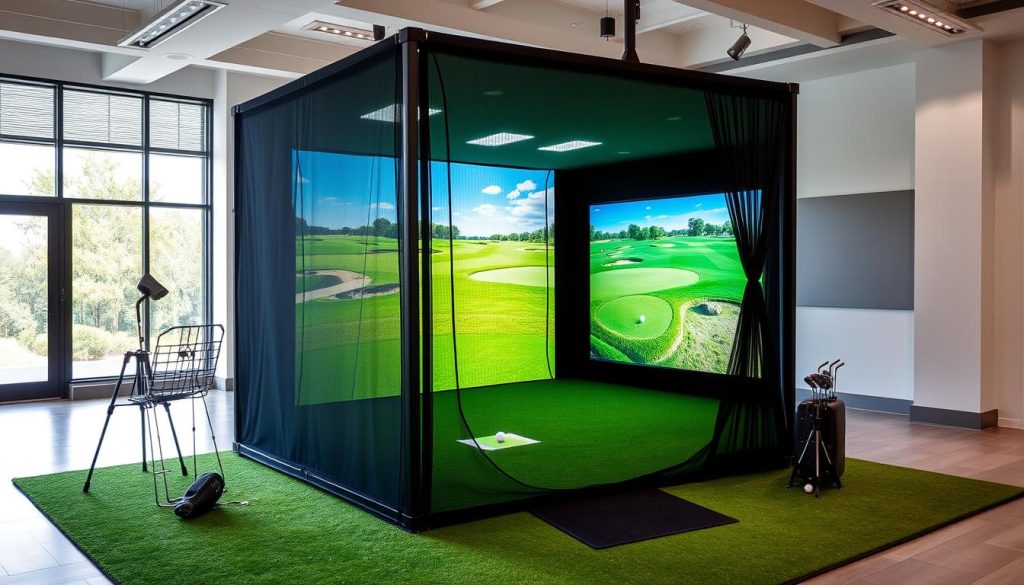
Considering Portability and Storage Options
When picking a golf simulator enclosure kit, think about how easy it is to move and store. If you have little space or plan to move your setup, look for kits that are easy to take apart and put back together.
Portable golf simulator kits are made for convenience. They have light, easy-to-assemble parts. This makes them perfect for those with small spaces or who like to move their simulator around.
- Easily disassemble and transport the enclosure
- Compact, space-saving storage when not in use
- Versatile setup options to suit your changing needs
Also, think about how you’ll store your kit when it’s not in use. Look for designs that can be folded or stacked neatly. This keeps your space tidy and organized.
| Feature | Benefit |
|---|---|
| Modular, Lightweight Components | Easy disassembly and transport |
| Compact, Space-Saving Storage | Maintain a clutter-free environment |
| Versatile Setup Options | Adapt to changing space and usage requirements |
Choosing a kit that’s easy to move and store makes your golf simulator experience better. It works well whether you’re setting it up at home, in the office, or on the go.
Assessing Lighting and Ventilation Requirements
The right lighting and ventilation in your golf simulator enclosure make a big difference. They ensure a comfortable and enjoyable space. Let’s look at what you need to consider for these key elements.
Lighting Considerations
Good lighting is essential for a great golf simulation. Think about your specific needs, including:
- Room size and layout
- Where the simulator and hitting area will be
- The brightness needed for clear ball tracking and visibility
- The cost and energy use of your lighting
Look at different lighting options. You might use overhead lights or task lights near the hitting area. Make sure the light is even and doesn’t cause glare. This will help create a bright and immersive space for your golf games.
Ventilation and Climate Control
- Temperature: Find the best temperature for your golf sessions and choose a system to keep it steady.
- Air flow: Make sure there’s enough air movement to keep the air fresh and comfortable.
- Humidity: Watch and control humidity to avoid too much moisture, which can affect your equipment.
Think about the size of your space and what ventilation you need. The right HVAC system or units can make your golf simulation more enjoyable.
| Lighting Factors | Ventilation Factors |
|---|---|
|
|
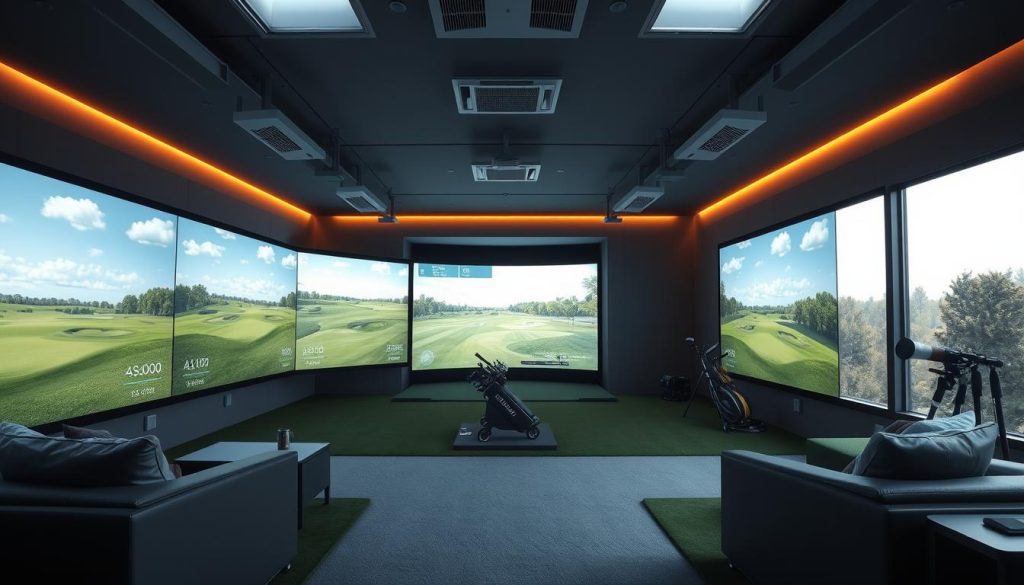
Integrating Additional Features
When it comes to your golf simulator enclosure, the possibilities are endless. You can add many features to make your indoor golfing better. It’s all about personal preferences and budget of course.
Customizing Your Enclosure for Optimal Performance
A ball return system is a great addition. It picks up your golf balls after each shot, making practice smoother.
For better sound, consider adding acoustic panels. They improve the audio quality and make your golfing feel more real. These panels help control echoes, giving you a clearer experience.
Adding a scoring display is another good idea. It lets you track your scores and share them with others. This adds a fun competitive edge to your indoor golfing.
| Feature | Benefits |
|---|---|
| Ball Return System | Convenient ball retrieval, uninterrupted practice |
| Acoustic Panels | Improved sound quality, reduced echoes and distractions |
| Scoring Display | Performance tracking, analysis, and shared experiences |
Planning for Installation and Assembly
If you go the DIY way, read the manufacturer’s instructions carefully and watch how to videos. Make sure you have all the tools you need. If you’re not sure, consider getting help from a professional. This will help you set up your golf simulator enclosure without any problems.
If you don’t have the time or technical knowledge then of course consult a professional.
Ready to get your Golf Sim Enclosure in place? If you need help getting started, talk to the pros at carlofet they be more than happy to help out!
FAQ
What are the key factors to consider when choosing a golf simulator enclosure?
When picking a golf simulator enclosure, think about a few things. First, how big is your space? Look for materials that last a long time. Also, consider the frame’s stability and if it’s easy to move.
How do I determine the ideal size for my golf simulator enclosure?
To find the right size, measure your space and your golf setup. Make sure there’s enough room for your swing and the ball’s path. This will help your enclosure fit perfectly.
What materials should I look for in a golf simulator enclosure?
Choose materials that are tough, won’t tear easily, and protect against UV rays. This keeps your enclosure looking good and lasting long.
What types of frames are available for golf simulator enclosures?
Enclosures come with different frames like aluminum, steel, or custom ones. Think about what’s important to you: stability, ease of moving, and looks. Pick the frame that fits your needs and budget.
How important is portability and storage when choosing a golf simulator enclosure?
Portability and storage are key if you have little space or plan to move your setup. Look for enclosures that are easy to take apart, move, and put back together.
What lighting and ventilation considerations are important for a golf simulator enclosure?
Good lighting and air flow make your golf sim better and more comfy. Think about what lighting you need and how to keep the air fresh.
What additional features can I consider for my golf simulator enclosure?
There are extra things you can add to make your golf sim better. Think about ball return systems, sound panels, or scoring displays. These can make your indoor golfing even better.

